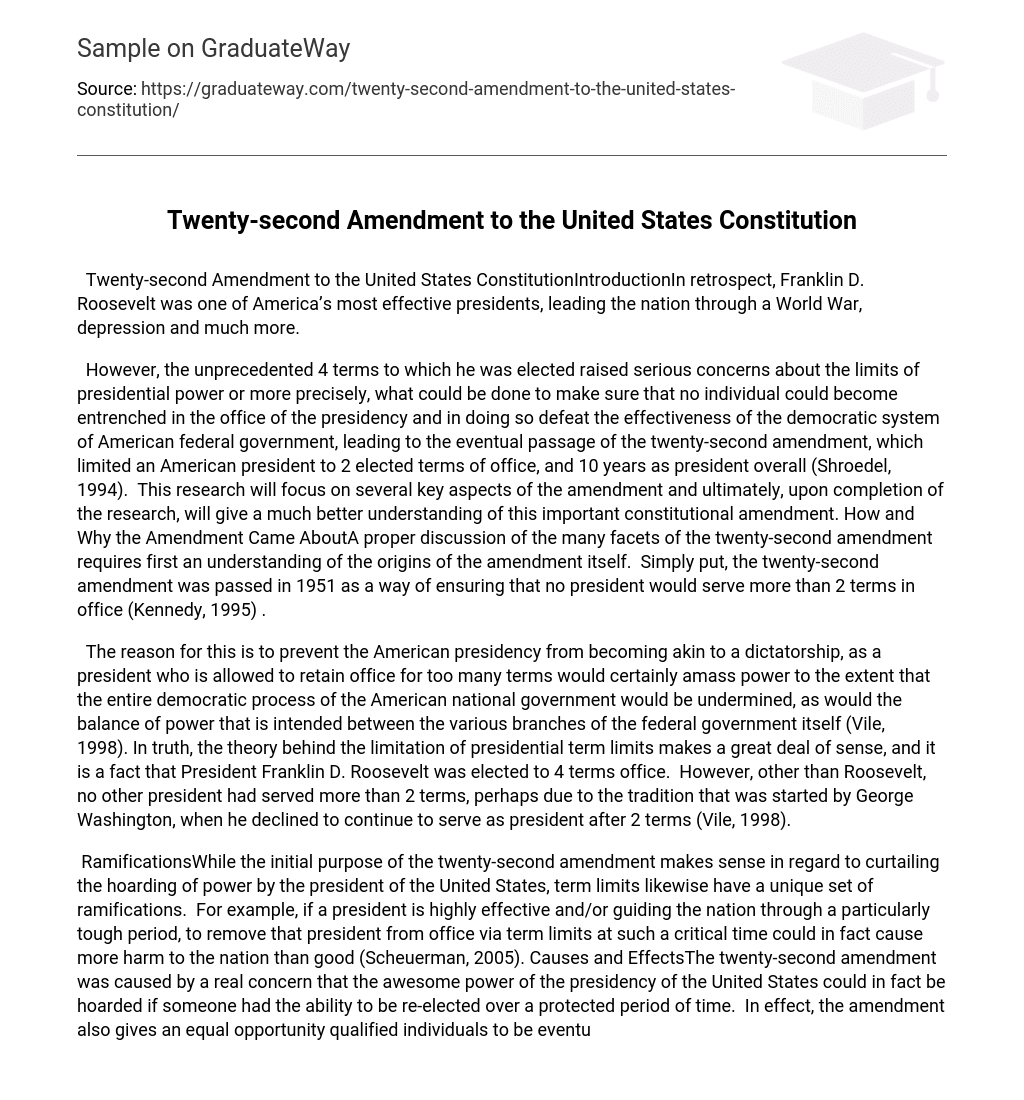Twenty-second Amendment to the United States ConstitutionIntroductionIn retrospect, Franklin D. Roosevelt was one of America’s most effective presidents, leading the nation through a World War, depression and much more.
However, the unprecedented 4 terms to which he was elected raised serious concerns about the limits of presidential power or more precisely, what could be done to make sure that no individual could become entrenched in the office of the presidency and in doing so defeat the effectiveness of the democratic system of American federal government, leading to the eventual passage of the twenty-second amendment, which limited an American president to 2 elected terms of office, and 10 years as president overall (Shroedel, 1994). This research will focus on several key aspects of the amendment and ultimately, upon completion of the research, will give a much better understanding of this important constitutional amendment. How and Why the Amendment Came AboutA proper discussion of the many facets of the twenty-second amendment requires first an understanding of the origins of the amendment itself. Simply put, the twenty-second amendment was passed in 1951 as a way of ensuring that no president would serve more than 2 terms in office (Kennedy, 1995) .
The reason for this is to prevent the American presidency from becoming akin to a dictatorship, as a president who is allowed to retain office for too many terms would certainly amass power to the extent that the entire democratic process of the American national government would be undermined, as would the balance of power that is intended between the various branches of the federal government itself (Vile, 1998). In truth, the theory behind the limitation of presidential term limits makes a great deal of sense, and it is a fact that President Franklin D. Roosevelt was elected to 4 terms office. However, other than Roosevelt, no other president had served more than 2 terms, perhaps due to the tradition that was started by George Washington, when he declined to continue to serve as president after 2 terms (Vile, 1998).
RamificationsWhile the initial purpose of the twenty-second amendment makes sense in regard to curtailing the hoarding of power by the president of the United States, term limits likewise have a unique set of ramifications. For example, if a president is highly effective and/or guiding the nation through a particularly tough period, to remove that president from office via term limits at such a critical time could in fact cause more harm to the nation than good (Scheuerman, 2005). Causes and EffectsThe twenty-second amendment was caused by a real concern that the awesome power of the presidency of the United States could in fact be hoarded if someone had the ability to be re-elected over a protected period of time. In effect, the amendment also gives an equal opportunity qualified individuals to be eventually elected to the presidency.
The Legacy of the Twenty-second AmendmentGiven the increasingly complicated world in which the United States plays such an important part, the issue of the legacy of the twenty-second amendment is especially important about which to theorize. There is a school of thought which holds that if a president in the modern day turns out to be exceptionally successful in the job, he or she should be allowed to pursue additional terms in office beyond the current limited 2 term system. Conversely, traditionalists stay true to the current limit that has been put into place. However an individual feels about the twenty-second amendment, it would seem clear that the rare exception of an outstanding president being allowed to serve as many terms as they can is outweighed by the requirement that the United States remain as the perfect example of a free nation, without any perceptions of dictatorship or monarchy.
As such, the limitation of presidential terms makes good sense and therefore would appear to be worthy of being permitted to remain in place. ConclusionThe twenty-second amendment stands, over half a century after its passage, as a vital measure to protect the true freedom which embodies the United States democratic system. Therefore, in conclusion, it should be understood that with time, this amendment has become even more important than it had been in the past, for if America does not remain free, a huge vacuum will exist in the international power structure, and there is every possibility that rogue nations could gain the upper hand. As this is totally unacceptable, the twenty-second amendment much stand as it now exists.
Works CitedKennedy, R. L. (1995). A Natural Aristocracy? Constitutional Commentary, 12(2), 175-177.
Scheuerman, W. E. (2005). American Kingship? Monarchical Origins of Modern Presidentialism.
Polity, 37(1), 24+. Schroedel, J. R. (1994).
Congress, the President, and Policymaking: A Historical Analysis. Armonk, NY: M. E. Sharpe.
Sen. Clinton and the 22nd. (2007, June 3). The Washington Times, p.
B03. Vile, J. R. (1998).
The United States Constitution Questions and Answers. Westport, CT: Greenwood Press. Works Cited





